Home
A comprehensive resource for safe and responsible laser use
US: 30 eye injuries May-July 2020 caused by police (not a laser)
The report focuses on kinetic impact projectiles (KIPs) such as so-called rubber bullets, baton bean-bag rounds, and tear gas canisters fired directly at protesters, journalists and bystanders. It specifically excludes chemical injuries such as from tear gas.
The effect of KIPs on the eye, according to the group, "nearly always causes total blindness in that eye, due to rupture of the globe (eyeball) as well as trauma to nearby structures."
The report notes that:
PHR’s database contains only incidents documented in traditional and social media. The tally depends on individuals to self-report their experiences, on journalists to identify and document injuries, or on the legal system to present these instances in the course of litigation. For these reasons, this count of injuries is believed to be only a fraction of the total number of people shot in the head and neck by U.S. law enforcement during the protests since May 2020….
In addition to the May 26 - July 27 2020 reports, the group also cited a "systematic review … of medical literature on kinetic impact projectiles over the past 25 years." This review found 1,925 injured people, 53 of whom died and 294 people with permanent disabilities. Further, "Permanent vision loss was the most common permanent disability."
The PHR report was cited in a May 20 2021 Narratively story (also published September 2 2021 at The Guardian) by photojournalist Wil Sands, whose right eye was blinded by a tear gas canister outside the White House on May 30 2020. Sands contacted others whose eyes were damaged by police using "less lethal weapons", told their stories, and has created an internet group for persons blinded by law enforcement.
Note: This story is part of our occasional coverage of eye injuries at protests which were not caused by a laser. This is because the number of actual or claimed laser eye injuries at protests (generally inflicted on police or security forces) is vastly outnumbered by actual or claimed eye injuries to protesters, journalists and bystanders (generally caused by police or security forces). In our view, no one should aim a laser or projectile at anyone's eye or head during protests, demonstrations and civil unrest.
US: Charges dropped against protester accused of laser pointer assault
Yusuf Labib had been arrested in March 2021 at a memorial for Breonna Taylor on a charge with "assault with force likely to cause great bodily injury."
At a court hearing, the prosecutor said "in this instance the People do not believe the evidence shows beyond a reasonable doubt that Mr. Labib specifically intended to cause fear of bodily harm.”
She continued, “The police officer in this case personally knew colleagues who have suffered permanent eye damage from lasers being shined in their eyes, so they take this conduct very seriously…. The People request Mr. Labib recognize that these potential risks exist before choosing to use a laser pointer in the future.”
Labib told the judge that he heard the prosecutor's comments.
From the Davis Vanguard
US: Missouri bill proposes 1-year sentence for pointing laser at police
A number of persons representing doctors and police officers supported the bill. Even the lone person in opposition to the bill supported the general idea but thought that the penalty was too harsh.
On March 2 2021, the Standing Committee on Public Safety in executive session voted 10 to 0 in favor of the bill. It was referred to the Rules - Legislative Oversight committee for further action.
Bill text at the Missouri House of Representatives 101st General Assembly HB 31 webpage. Story from the News & Record, though it is difficult to tell whether the bill described in the story is this one or is HB280 which does not appear to include laser misuse in its text.
US: Arizona law proposes stronger penalty for laser misuse during disorderly protests
Currently, this offense is a Class 1 misdemeanor. House Bill 2309, if passed, would make this a Class 6 felony if the "offense occurs in the course of committing violent or disorderly assembly."
A Class 6 felony is considered aggravated assault, with a mandatory minimum six month jail term.
"Violent or disorderly assembly" is a new term created in the bill, defined as follows: "A person commits violent or disorderly assembly if, with seven or more other persons acting together, the person, with the intent to engage in conduct constituting a riot or an unlawful assembly, causes damage to property or injury to another person."
As of February 24 2021, the bill was reported out of committee to the House.
From the Martinsville Bulletin
US: Los Angeles bans lasers from demonstrations
At an October 27 2020 public meeting, the deputy chief of the L.A. Police Department, said "… we have experienced numerous instances of individuals among these groups intentionally using laser devices and pointers to attempt to blind and cause harm to officers by pointing them purposely at their eyes…. Laser-type devices have no legitimate use outside of the business or educational venues."
The department warned officers to "adjust their vision" to avoid laser beams, and "has since sought to use eyewear and screens" to protect eyes from laser light.
An LAPD spokesperson said thus far in 2020, there had been 20 incidents of laser pointers being used to blind or distract people. Twenty-four people reported eye damage during the incidents, according to the spokesperson. Twenty of them were police officers; some were driving at the time.
The Los Angeles Times reported "In July, LAPD Officer Kyle Rice lost his vision in his right eye, as well as his ability to balance, and was left with migraine-like headaches after he was targeted with a laser pointer after responding to a radio call of a disturbance in Little Tokyo. A person not involved in the dispute between an homeless person and a business owner is accused of pointing the laser at Rice’s eye. An arrest was made in the incident."
According to the L.A. Sentinel, "Some people who spoke during the meeting said it was ironic that the LAPD was asking for a laser-pointer ban at protests, as officers have been photographed using bean bag projectiles that have allegedly caused gruesome injuries to some protesters, such as lost eyeballs and teeth."
Section 55.07 also prohibits items such as wood, pipe, hard signs, baseball bats, aerosol spray (tear gas, mace, pepper spray), firearms, BB guns, tasers, knives, glass bottles, open flame torches, shields of metal, wood or hard plastic, bricks, and rocks.
From the Los Angeles Times, and from the City News Service via the L.A. Sentinel and NBC Los Angeles. More on officer Kyle Rice is here.
US: Journalist describes being hit in eye with suspected pepper ball round in Portland (not a laser)
Trip Jennings had worked at protests around the world. His photos and videos have appeared in National Geographic and PBS.
In Portland, he said he was walking away following a dispersal order. He had his camera above his head so security forces could see he was a journalist, "but as soon as I turned around just a little bit, they shot me in the face…. I got hit right in the eye. I remember seeing the lens of my gas mask shatter and then closing my eye and just blood inside of my mask." He believes agents shot him with a pepper ball.
He did not lose vision in the eye which was shot.
From CNN and Business Insider
Note: This story is part of our occasional coverage of eye injuries at protests which were not caused by a laser. This is because the number of actual or claimed laser eye injuries at protests (generally inflicted on police or security forces) is vastly outnumbered by actual or claimed eye injuries to protesters, journalists and bystanders (generally caused by police or security forces). In our view, no one should aim a laser or projectile at anyone's eye or head during protests, demonstrations and civil unrest.
US: Report describes 12 severe eye injuries during late May 2020 protests (not a laser)
According to the Post, "in three instances, video evidence undermines official accounts of what happened." The report said four additional people were also partially blinded by police during the week that included May 30.
From the Washington Post
Note: This story is part of our occasional coverage of eye injuries at protests which were not caused by a laser. This is because the number of actual or claimed laser eye injuries at protests (generally inflicted on police or security forces) is vastly outnumbered by actual or claimed eye injuries to protesters, journalists and bystanders (generally caused by police or security forces). In our view, no one should aim a laser or projectile at anyone's eye or head during protests, demonstrations and civil unrest.
Gaza Strip: WHO says 21 persons lose vision during 21 months of Palestinian demonstrations (not a laser)
The injuries were tallied during the 21 months from March 30 2018 until December 31 2019. There was no further information on the causes, nature, and prognosis of the injuries.
From the WHO Health Cluster Bulletin, Nov-Dec 2019 issue (see page 2, last sentence in the fourth bullet point). Link and photo from B'Tselem article Feb. 24 2020 article, updated Feb. 27 2020.
Note: This story is part of our occasional coverage of eye injuries at protests which were not caused by a laser. This is because the number of actual or claimed laser eye injuries at protests (generally inflicted on police or security forces) is vastly outnumbered by actual or claimed eye injuries to protesters, journalists and bystanders (generally caused by police or security forces). In our view, no one should aim a laser or projectile at anyone's eye or head during protests, demonstrations and civil unrest.
US: Ophthalmologists cite 20 eye injuries from U.S. protests (not a laser)
- 7 persons lost an eye, "with additional patients undergoing surgery to save their eye"
- Persons who lost an eye ranged in age from 21 to 37 years
- Persons with an eye injury ranged in age from 16 to 59 years
- Injuries were caused by rubber bullets, bean bag rounds, pepper balls, a tear gas canister, and a corneal injury from a taser.
In addition, the AAO press release had links to stories about eye injuries during protests in Kashmir, Chile and Hong Kong.
On June 3 2020, AAO issued a statement condemning rubber bullet usage, and giving tips on eye protection from projectiles and from tear gas. They noted that tear gas "typically doesn’t cause irreversible eye injuries, but tear gas has caused serious eye injuries, including hyphema, uveitis, necrotizing keratitis, coagulative necrosis, symblepharon, secondary glaucoma, cataracts and traumatic optic neuropathy and loss of sight."
A day later AAO provided information, social media handles, photos and graphics in a post called "Help Us Stop Rubber Bullets Before They Blind More People."
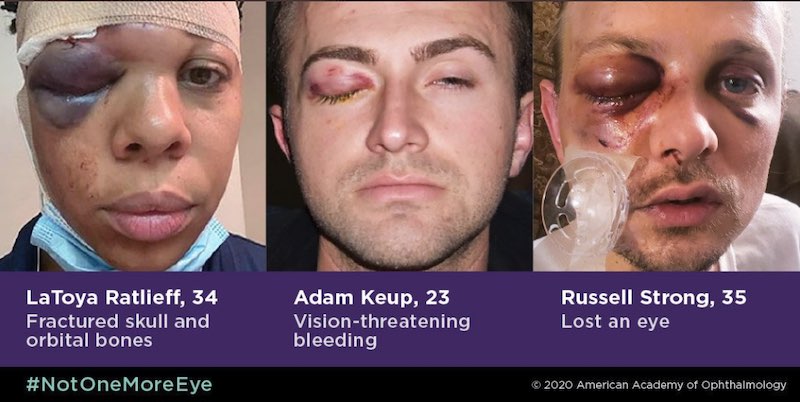
Graphic tweeted by AAO
Note: This story is part of our occasional coverage of eye injuries at protests which were not caused by a laser. This is because the number of actual or claimed laser eye injuries at protests (generally inflicted on police or security forces) is vastly outnumbered by actual or claimed eye injuries to protesters, journalists and bystanders (generally caused by police or security forces). In our view, no one should aim a laser or projectile at anyone's eye or head during protests, demonstrations and civil unrest.
UK: Professor develops laser-absorbing strip for police face shields; "several thousand" used in Northern Ireland
The strip was developed by John Tyrer of Loughborough University, professor of optical instrumentation. He was commissioned by the Home Office and the PSNI who were concerned about increasing numbers of demonstrators aiming laser pens at police.
The light distracts officers and breaks their positions, according to Tyrer. The orange-tinted film is low-cost and simple to apply.
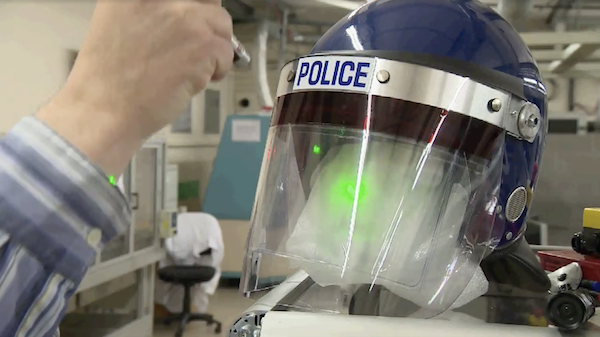
Tyrer demonstrates how light from a laser pen goes through the clear part of the face visor, causing glare and potential eye injury to an officer.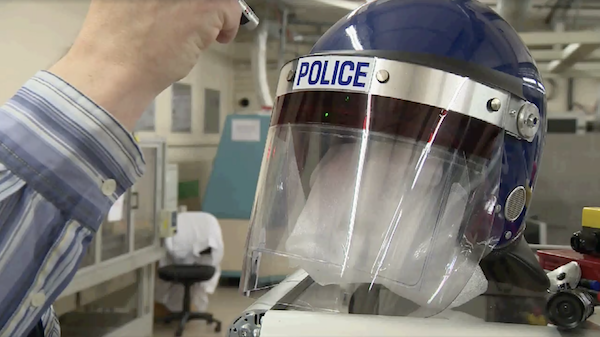
But if the officer tilts his or her head down so the laser goes through the strip, laser light is absorbed and does not present a hazard.
Testing by Public Health England, and real-life usage in Northern Ireland, showed the anti-laser strip to be “very effective”.
Tyrer has also suggested that the same film applied to glasses can protect pilots during takeoffs and landings from any laser activity that might be occurring.
From the Loughborough News Blog and Police Oracle
UPDATE JULY 27 2020: The visor strips are sold by Laser Optical Engineering Ltd. in the U.K. Pricing is £25 (USD $32) per strip in low quantities (<200). According to LOE, in field use it was found that direct attacks on police "stopped quickly" once protesters knew their lasers were ineffective and that laser attackers would be identified and arrested. LOE also sells anti-dazzle glasses. Pricing is £50 (USD $64) each in low quantities (<50).
Additional information about laser use and mis-use at protests, and ways to protect eyes is on the Laser use during protests page.
India, Kashmir: Hundreds of severe eye injuries from government pellet shotguns (not a laser)
An August 28 2016 New York Times article describes some of the lead pellet-caused eye injuries:
“The patients have mutilated retinas, severed optic nerves, irises seeping out like puddles of ink.”
“[A] patient’s eyelids have been stretched back with a metal clamp, so his eyeball bulges out of glistening pink tissue. The surgeon sits with his back very straight, cutting with tiny movements of his fingers. Every now and then, a thread of blood appears in the patient’s eye socket. The patient is 8 years old…. Slowly, as residents stood around him in hushed silence, the surgeon flattened out the boy’s retina, as thin and delicate as a lace doily, and used a laser to reattach it to the back of his eye.
“In most cases, it became clear, the pellets had burst into through the cornea and out through the retina, leaving little hope of fully restoring vision…. ‘Once it goes in the eye, it rotates like this, and destroys everything there inside,’ Dr. Qureshi said. ‘It’s physics. This is a high-velocity body. It releases a high amount of energy inside. The lens, the iris, the retina get matted up.’”
The author, Ellen Barry, notes that “….most countries do not use them on unarmed civilians, as the pellets spray widely and cannot be aimed…. This year, the use of pellets on Kashmiri protesters increased sharply, with the police firing more than 3,000 canisters, or upward of 1.2 million pellets, in the first 32 days of the protests, the Central Reserve Police Force has said.”
From the New York Times
Note: This story is part of our occasional coverage of eye injuries at protests which were not caused by a laser. This is because the number of actual or claimed laser eye injuries at protests (generally inflicted on police or security forces) is vastly outnumbered by actual or claimed eye injuries to protesters, journalists and bystanders (generally caused by police or security forces). In our view, no one should aim a laser or projectile at anyone's eye or head during protests, demonstrations and civil unrest.
Switzerland: After laser pointer attacks, first responders will have laser protective eyewear
After tests in mid-2013, the Basil Justice and Security Department purchased 1,000 pairs of laser protective eyewear, at 200 Swiss Francs each (USD $224).
All Basel police officers and rescue emergency vehicles are equipped with the glasses, as of December 2013. Other Swiss cantons are in the testing phase.
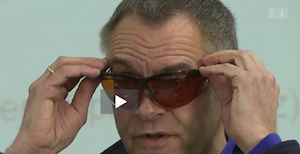
The Basel anti-laser glasses are demonstrated in this frame from a SRF video.
From a December 16 2013 report by Schweizer Radio und Fernsehen, (original German text and Google-translated into English). Thanks to Basel officer Ruedi Maier for bringing this to our attention. For additional news items from Switzerland, including the 2011 purchase of laser protective eyewear for air rescue helicopter pilots, click here.
UK: Police dazzler laser being tested to flashblind rioters
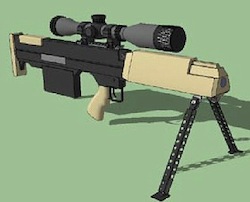
Concept of the rifle, from the Daily Mail
The developer is Photonic Security Systems, which also markets the rifle as a pirate deterrent. The Telegraph says that similar devices have been used in Afghanistan by NATO-led International Security Assistance Force troops.
PSS managing director Paul Kerr told the International Business Times "The very purpose of this technology is to be non-damaging … If someone is prepared to just stand there and stare down the barrel at this, which would be incredibly uncomfortable, then they are definitely a threat.” He said that he has often been exposed to the laser: "The quality and safety of the device is paramount and I know that first hand because I have been the guinea pig many times. I know what it is like and I know how effective it can be."
Author and activist Cory Doctorow points out that “the UK is a signatory on the Protocol on Blinding Laser Weapons … this weapon wouldn’t run afoul of international law if it (merely) reduced your vision to the point where you were impaired but not legally blind, permanently.” Doctorow also says “Twitter wags are already predicting a resurgence of mirrorshades [reflective sunglasses] among protesters.”
From the Telegraph, the Daily Mail, the International Business Times and BoingBoing. See related story on BAE Systems anti-pirate dazzler.
.